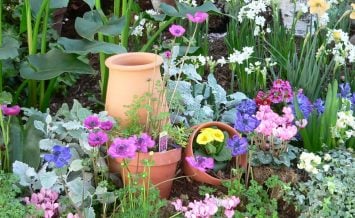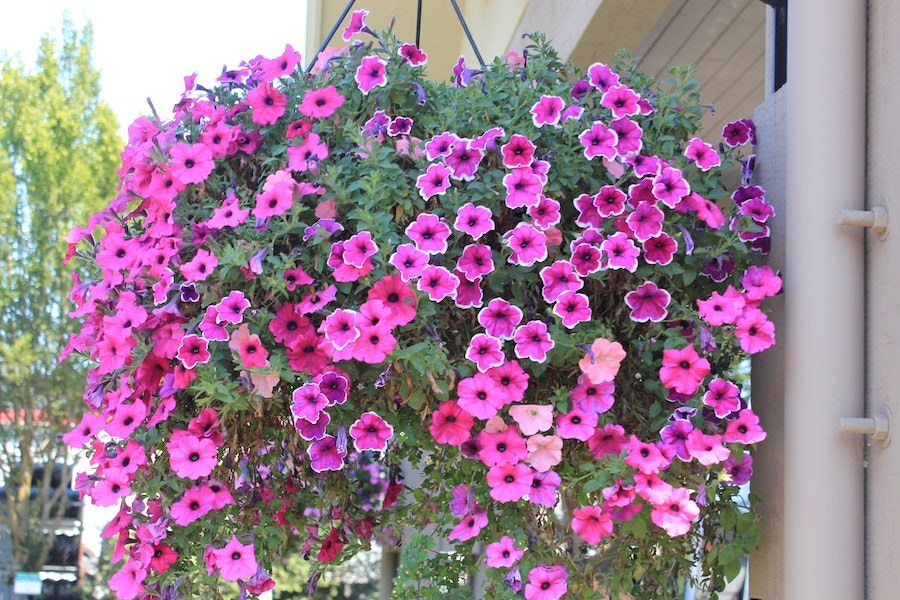5 tips for creating a hanging basket from scratch
So, do you buy your hanging basket ready-made from a garden centre, or plant it yourself?
It’s a question many time-strapped gardeners ask themselves. You can snap up a filled basket, already brimming with blooms, for between £15-£20 from some online retailers and garden centres which, if you feed, water and deadhead religiously, should last through summer.
Indeed, you may not save any money opting to make make up your own, once you factor in all the components involved (mature bedding, the basket itself, the liner, water-retaining crystals and slow-release plant food…), but there are certainly advantages in planting up your own hanging basket.
You get to choose the style, exact plants and colours, as well as being safe in the knowledge you’ve put them in suitable compost containing all the nutrients they should need for summer. You may have sown seed earlier on, so have far more plants to disperse among numerous baskets and containers – and there’s a joy in growing your own beautiful blooms from seed.
Fancy giving it a go? Here are five tips for creating your own gorgeous hanging basket…
1. Choose a basket and liner

Easy Fill basket
There are many on the market, from traditional wicker and wire circular types, to conical containers and baskets which have water reservoirs in the bottom and removable ‘gates’ at the sides, which allow you to plant your plants and then secure them by replacing the gates.
Those who want natural-looking liners may go for sphagnum moss or coir. Some gardeners then line the liners with plastic of some sort, whether it be from an old compost bag or a rubbish liner and put holes into the plastic to allow for drainage. I have tried this and it does help retain moisture, so the compost doesn’t dry out so quickly. Others swear that the best liner is an old woolly jumper, which is stretchy enough to allow you to plant your chosen blooms through, but also retains moisture.
2. Select your plants

Geranium plug plants are drought tolerant
If you are making your hanging baskets up now, you may still be able to buy some bargain plug plants – baby plants that cost less than larger equivalents – which should be easy to plant in your basket. Good bedding for baskets include geraniums, petunias, bacopa, lobelia, verbena, diascia and fuchsia, although some require more watering than others.

Fuchsias need plenty of water
Fuchsias, for instance, tend to be thirsty, while geraniums are more drought tolerant. Busy Lizzies and hostas are good if your basket is going to be in a shady spot.
Styles vary – some gardeners prefer a globe of the same variety and colour, to create order and continuity, and tend to be lower maintenance as the same plants will have the same needs in terms of watering and feeding. Others will plant a riot of different colours in the same basket, some trailing, some bush varieties. If you are going for a mixture, plant trailers on the outside or at the sides of the basket and a feature bush plant in the middle to create some height and balance.
3. Use good compost

Use rich, fertile compost
You can buy compost specifically for hanging baskets, which already incorporates water retaining crystals and plant food, but if you already have multipurpose compost, add a handful of slow-release plant food granules and water-retaining crystals to the mix. If you are planting a longer-lasting basket with more permanent plants, such as hostas and heucheras or evergreens including skimmias and variegated ivies, use John Innes No 2 compost.
4. Think about the planting process
Once you have lined your pot, put in compost up to the first holes at the side, then insert your plants and place more compost over them. Leave enough depth to plant your main subjects at the top of the basket and then infill around them with more compost. I generally sit the basket on a bucket, which allows me to turn the basket while planting up the sides, without damaging any plants.
5. Don’t forget about maintenance
If you’re planting your baskets up now, most of the annuals you use won’t be frost hardy, so make sure you bring them under a porch or under cover in the evening until all chance of frost has passed. They will need watering thoroughly at least once a day initially, and possibly twice a day during the height of summer. If your basket dries out, don’t just get the hosepipe out on it as the water will just come through.

Baskets which have dried out should be dunked in water
The best way to re-hydrate the soil is to take the basket down and place it into a washing-up bowl of water, until the soil has become soaked underneath. Then you have some chance of reviving it. Deadhead the blooms regularly to keep them going throughout summer and give them a diluted feed once a week, even if you have plant food in your compost, especially towards the end of the season when the nutrients in the soil will have drained out.
The Press Association
Latest posts by The Press Association (see all)
- 6 foods that are great for your heart health - April 8, 2025
- Award-winning actors to star in Second World War film released for VE Day - April 8, 2025
- King Charles and Queen Camilla release official 20th wedding anniversary photographs - April 7, 2025
- The 5 ways drinking alcohol can affect your body - April 7, 2025
- Why you should welcome these scary-looking critters into your garden - April 7, 2025




















